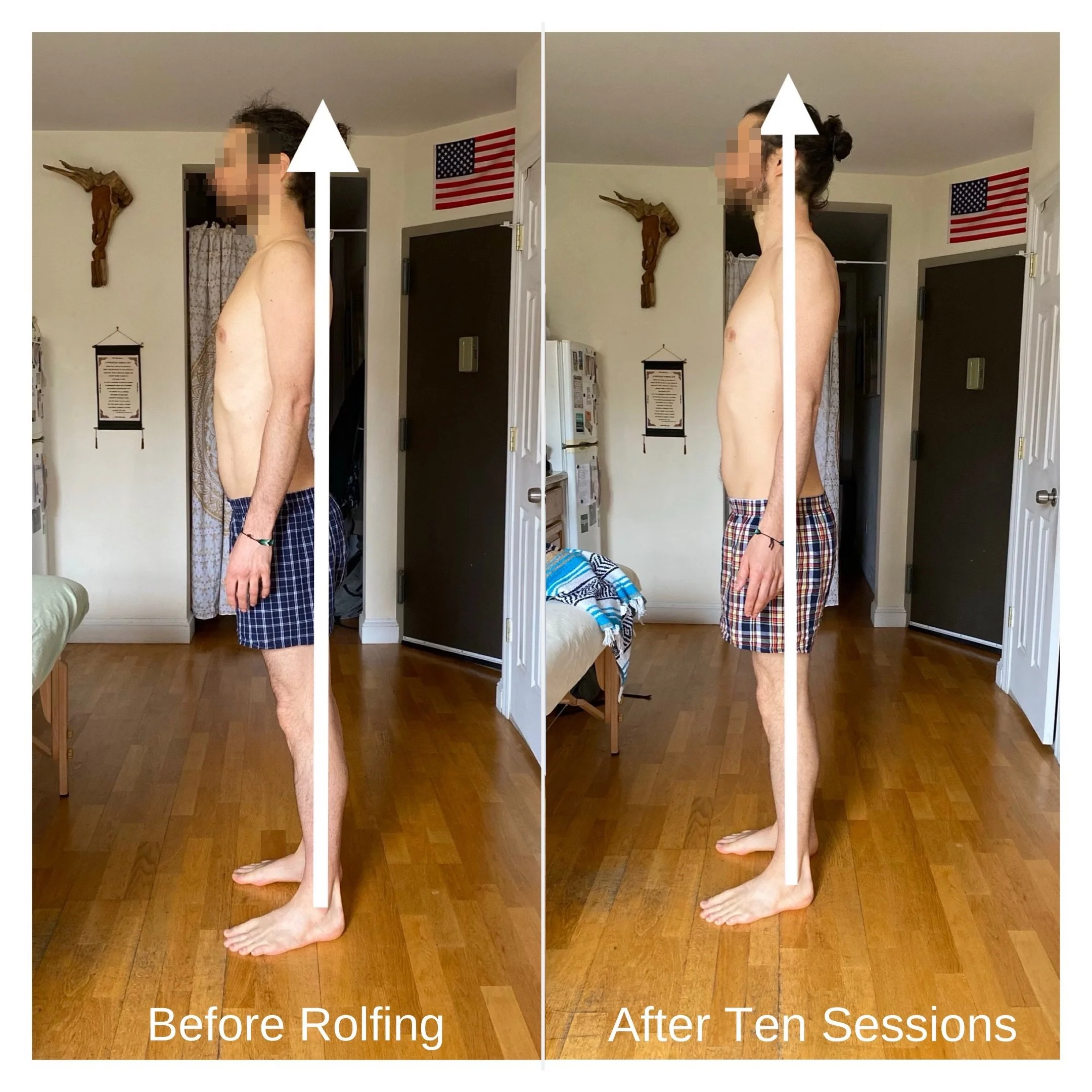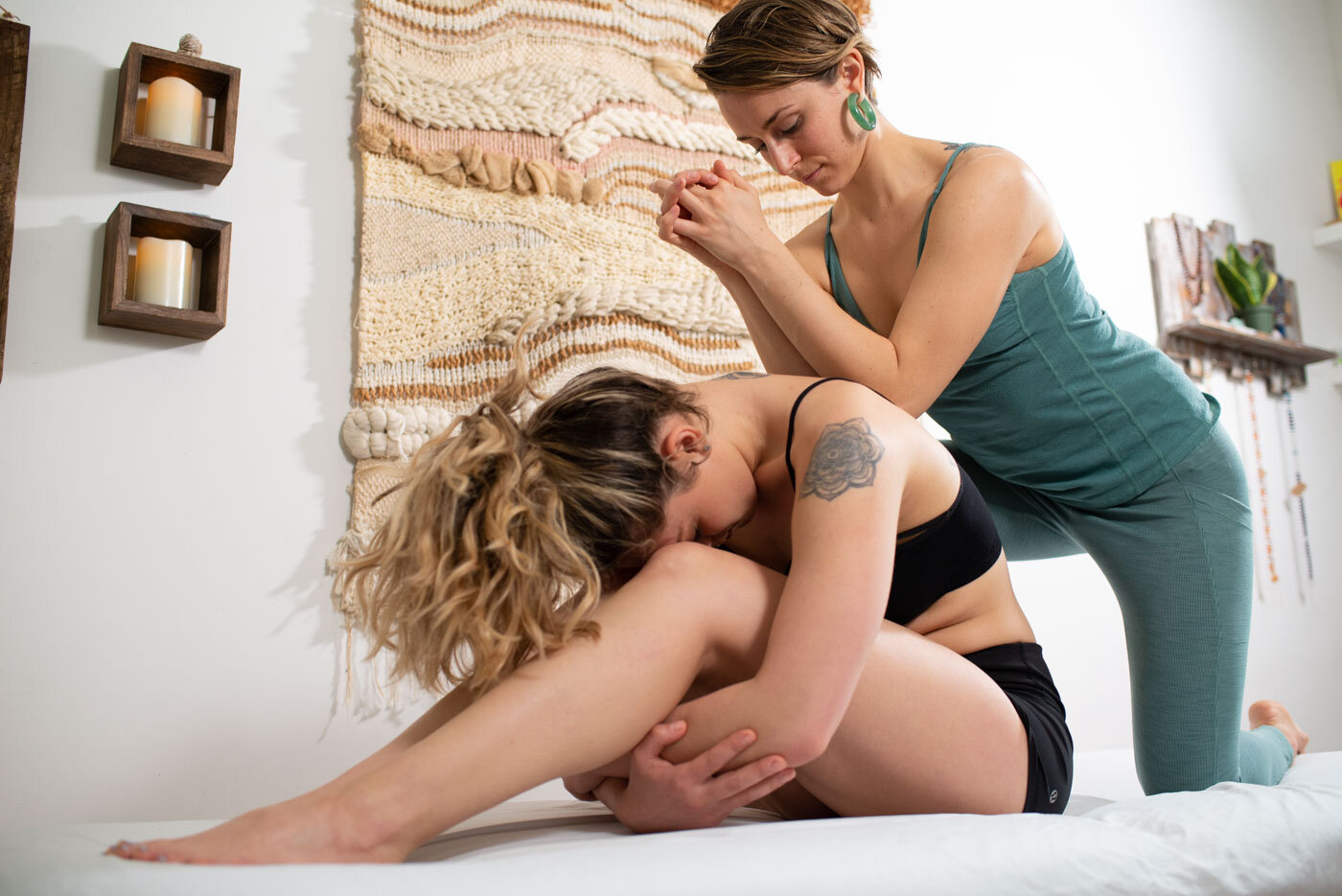Improve posture, reduce pain & stubborn tensions, and optimize athletic performance with Rolfing.
Say hello to your new body.
Rolfing is a 10-Session protocol that treats the entire body to bring about long-lasting changes in pain, posture, somatic healing, and athletic performance. Rolfers are interested in balancing the body in relationship to gravity; releasing restrictions that inhibit free movement; and coordinating body, mind and breath for strength, grace, enjoyment and efficiency. This work often affects not only the physical structure, it often impacts physiological functioning, emotions, thought patterns and relational behaviors. The empowered self-awareness and new movement patterns gained through the 10 sessions serve as a foundation upon which the client can learn to undo troublesome patterns, avoid injury, and mitigate the negative effects of aging.
What does Rolfing help with?
Pain/Excessive Tension
Because Rolfing looks at and treats the body as a whole of interconnected parts, it can help with pain and excessive tension anywhere in the body. Some of the problems I have successfully treated include pain, restriction, weakness, and/or excessive tension in the back, neck, jaw, shoulders, wrists, hips, knees, ankles and feet.
Some clients feel no physical pain but love the positive effects that Rolfing has on their mind and emotions. Rolfing is powerful self-care that can positively impact your life and sense of well-being.
Athletic Performance
Whether you are a yoga student, CrossFit athlete, runner, tennis player, and everything in between, Rolfing can help you with you move better so you can continue doing what you love.
Alignment
As we age, we may notice that gravity starts to take over in ways that aren’t so ideal. It can affect our posture, spine, gait, breath, quality of life, and even our confidence and self-esteem. It is possible to age gracefully and we can support our longevity beginning at any age. The uncomfortable postural habits, old injuries, and imbalances can be brought back into order. Rolfing awakens the intelligence of the body and brings you back towards your healthy blueprint.
Strength & Mobility
Ida Rolf said that real strength is the result of ease, rather than effort. She also noted that a truly strong, healthy muscle must be able to both contract and fully relax. Rolfing uncovers your compensations, your areas of tension and excessive effort, and integrates them into the whole of your body where true strength abides.
Before & After Ten Rolfing Sessions
What Can I Expect?
First, come on in and try a session to determine if this approach is a great fit for your needs. You’re not obligated to commit to anything right off the bat.
A typical Rolfing session involves a verbal check-in, walking + movement assessments, and hands-on bodywork on the massage table and/or chair. Depending on client needs and sensitivity, the bodywork may address all layers, from skin and superficial fascia to muscle and deep fascia, joints and organs. You should NEVER feel a bad kind of pain, or too much intensity for you to breathe through. Your safety is always my top priority.
There is an opportunity for us to include Somatic Experiencing® (SE) during the sessions, which essentially means that we can explore the interconnection between your mind, emotions, sensations, and symptoms in your body. Sometimes, this aspect of the work is very helpful for clients to process the life experiences and emotions that get “stuck” in their physical body. I can include SE during your Rolfing session(s) based on your needs and interests. I am committed to using the best approach(es) for you to achieve your goals, and welcome you to provide feedback to help me tailor our treatments.
At the end of the session you will be invited to walk and move around again to reassess any changes in movement, awareness, pain levels, and structure. We’ll likely include some integrative homework in the form of movement, breathwork, and/or mindfulness of daily habits.
Integrative Homework
One aspect that makes my approach uniquely effective is the inclusion of homework that helps you integrate the changes from each session. I will include this in most of your sessions, especially if you express a keen interest in taking on this kind of agency in your process. Homework may range from corrective exercises to simple awareness and adjustment of how you move through life. Your awareness and proactivity is what makes the work “stick.”
The Benefits of a Rolfing Ten Series
Ten sessions to holistically align, reset and balance the entire body
If you are new to Rolfing, this is the place to begin. The Ten Series is like a recipe, but each person’s series is unique and tailored.
INTRODUCTORY SESSIONS
Session 1: First and foremost, the client and practitioner establish mutual trust and communication. Session 1 usually focuses on freeing restrictions in the shoulders, hips, and rib basket and spine in order to optimize the breath. Breathing is one of our most important physiological functions. Suboptimal breathing patterns are extremely common and the effects are far-reaching throughout the body and mind.
Session 2: Simply put, modern living has stolen functionality from our feet. This session primarily works on the feet and lower legs to tune up the arches, restore function to the ankles and knees, and mobilize the bones of the feet. Tissue restrictions in the muscular compartments of the calves will also be addressed. Session 2 finishes with neck work and seated work on the back to connect the support of the feet to the length of the spine. Though the focus of this session is mainly on the lower limbs, chronic neck and shoulder issues often benefits from improving our foundational support.
Session 3: This “lateral line” session looks at the client’s vertical stacking - from ear to ankle bone - to work on misalignments that cause compression in the body. This session is excellent for addressing overhead mobility, tight hips and lower back pain. Expansion, freedom and lightness are feelings often reported from session 3.
CORE SESSIONS
Session 4: Here we begin restoring the midline from the ground up. We’ll work from the inner arches of the feet up the inner leg to the bottom bones of the pelvis and spine. We’ll also focus on pelvic floor education - the ability to feel, contract and relax these muscles, and how they relate to the breath. This session often helps with balance and alignment in the lower limb/pelvis and may relieve hip and low back problems. We’ll then work on the back to connect the support of the legs to the spine.
Session 5: The Psoas Session! Work is usually on the front of the legs and pelvis up to the front side of the lower spine where the iliopsoas muscles live. This will be integrated with mobility in the thoracic spine. Old patterning around poor posture and inefficient walking can be replaced with a new, uplifted sense of self. Because of its placement deep within the core of the body, the psoas is sometimes linked to stored trauma, stress or emotions. We’ll safely and compassionately work through whatever comes up for you.
Session 6: The Deep Back Line. Here is where we address the fascial relationships of the soles of the feet, calves, hamstrings, sacrum, and spine. Getting the back of the body long, balanced, free and awake makes this session a favorite for many.
Session 7: “Putting the head on top” We have worked up the midline from the ground up to the front and back of the spine, and now we need to balance that heavy noggin on top. The body is now ready to integrate a fully aligned posture from head to toe. We’ll have the option to work inside the mouth which is excellent for jaw issues. This session is particularly excellent for neck problems and “head forward” posture.
INTEGRATION SESSIONS
Sessions 8 & 9: These sessions focus on larger, more complex relationships across multiple joints. Highly individualized, these are the “jazz improv” of the Series which seek to establish integration of the new patterns as graceful movement that creates length throughout the entire body.
Session 10: Traditionally, this is a whole body session that looks to leave the client feeling light, energized and balanced. Ida Rolf used the term “Uniform Brilliance” to describe the energetic field that a body exudes after its Tenth session. This is also a time to decide if we’ll be wrapping up our work together or if you’d like to continue with maintenance sessions.
-
65 min - $230 (returning clients only)
90min - $280 (new or returning clients)
120 min **includes a combination of bodywork, Physiyoga and/or Somatic Experiencing® - $335 (new or returning clients)
$20 discount for cash payment
Add-on options
Breathwork - 30 min $65
Breath is the foundation of good health. Includes breathing assessment and various pranayama and modern breathwork practices to bring balance to the structural and nervous system components of breath.
Physiyoga - 30 min $65
Supports longevity, optimizes athletic performance and injury treatment/prevention. Includes movement assessment and tailored corrective exercises to restore anatomical function in everyday life and in the exercises we enjoy. You will not get this personalized attention on Youtube or Instagram!
Restorative Yoga - 30 min $65
Offers deep rest and reset for the nervous system through passive, comfortable, long-held yoga poses using the support of props, hand on-assists and skilled verbal cueing. Wonderful medicine when you feel exhausted, burnt out or overwhelmed!
Custom Yoga Flow - 30 min $65
Many people know they "need to do yoga" but have trouble knowing which poses to do, how to perform the poses correctly, and when to carve out space for it within their busy schedules. Why not feed two birds with one hand and move through a yoga flow that's customized to you during your Rolfing appointment?
Thai Hot Herbal Compress - $35
Advanced relief from pain, stress, tension, inflammation, GI upset and/or menstrual problems using all natural Thai herbs









